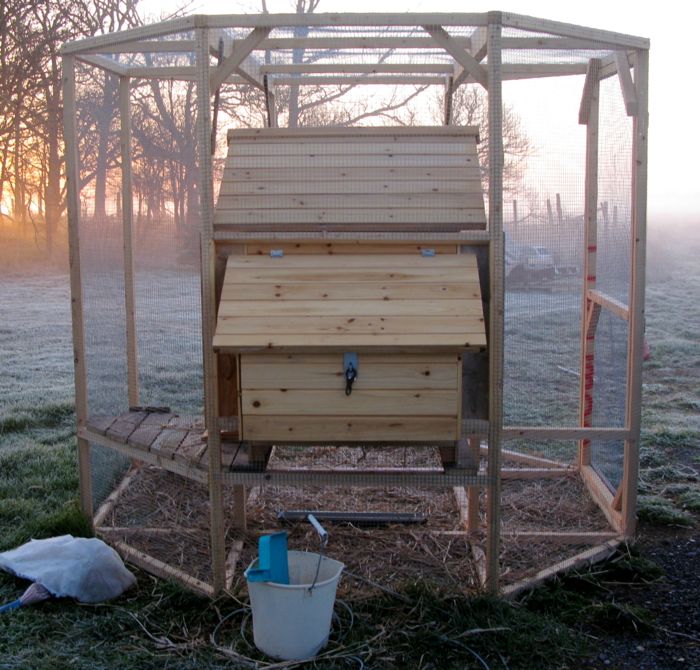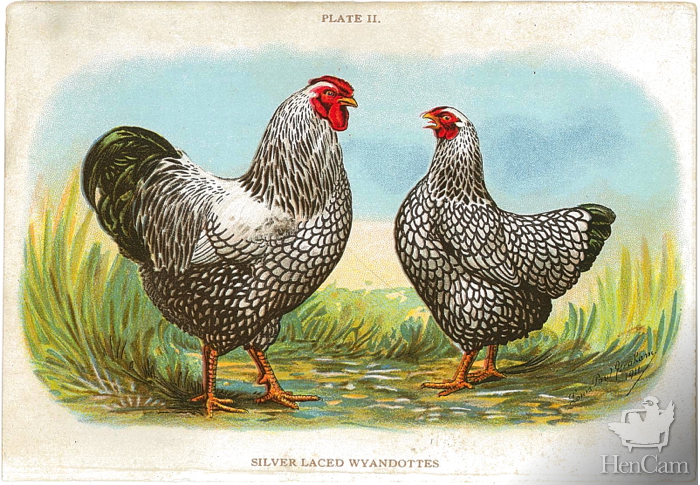This winter I’ve fielded a number of queries about frostbite on hens’ combs. A mild case of frostbite will cause darkening on the tips of the comb. Severe frostbite will cause swelling and pain. The affected parts of the comb might die and fall off. The other chickens will peck at the damage and that can cause terrible bloodshed. Roosters lose their fertility, and hens with frostbite stop laying. Frozen combs are serious, but not too common. It happens more often with roosters with particularly large combs because the boys don’t tuck their heads in when they sleep at night. But, I wasn’t being asked about roosters. I was hearing about bad cases of frostbite in winter hardy hens that have modest-sized combs. That simply shouldn’t happen.
Over the years I’ve kept a range of hens with combs of various sizes. Temperatures here can stay well below freezing for weeks. As you’ve seen this winter, we’ve had snow, freezing rain, sleet and even a blizzard. I don’t use heat. My hens, and their combs, are fine. So, why were other people having problems with their flocks? The culprit is the housing. I have been railing against small, poorly ventilated coops for years. Unfortunately, these are the ones that are advertised to the beginner poultry keeper. They are too small. They have terrible ventilation and become damp and cold. They have little headroom so that the chickens are roosting low to the ground, right over their manure. Manure is 75% moisture. Your hens will be breathing that moisture in. It will coat their combs and turn them icy cold. Also, hens breathe out moisture. I’ve read that 25 hens give off one gallon of moisture every 24 hours. A small coop can get damp quickly. Those small coops will make your hens ill.
One reader with a flock of sex-links kept her birds in this coop. There are no windows and poor ventilation.
An added factor was that she bedded with straw, which holds in moisture. Pine shaving dries out manure; straw goes moldy. Fortunately for her hens, she recognized the problem before it got severe. She has since moved her flock to a large shed and their health has improved.
One of the issues that I have with these small, dog house-like coops, is that you can’t walk in them. I go into my coops several times a day. I can tell what the temperature is, if it feels damp, if it smells rank or moldy. A glance inside one of these prefab coops won’t give you that essential information. If you have one of these small coops, put your head and as much of your torso in there as you can. Take a sniff. Feel the air. Would you be comfortable breathing in there all night? If not, the housing needs adjusting. There are plenty of good small coops out there. I have a Pinterest board with annotated photos of coops that I like. Do plan on at least 4 square feet per hen.
You can also select hens that have been bred for wintery conditions. Hens with lots of feathers and small combs will stay active and healthy throughout the cold weather –
– that is, as long as they have a dry, well-ventilated, sunny and spacious coop.



I wonder if a concrete floor is bad for the chickens feet in the cold or is a dirt or wood floor better?
I have a concrete floor. Easy to clean. Keeps out vermin. Stays dry. Doesn’t hold moisture. Cool in the summer, but, yes, colder in the winter, and so I bed it a bit deeper.
Thank you Terri, Im going to build with concrete. They have straight run leghorns and mixed pullets at Tractor supply so Im going to pick a few pullets and see what they turn into! Im sure my 2 chickens will enjoy some company and I will to!
My Tractor Supply just got their chicks in today! Im excited to go pick out a few!
I have had minor frostbite on only 3 hens with larger combs just the very tips, and whenninnoticd that the got the vasoline treatment
I call those chicken caughins as in coffin and coughing. I also made that very expensive newbie mistake.
We bought 7 acres in 1980 that had an old coop on it that we used. It was way up off the ground on four 2/4s, had only three sides and faced south. The back had a hatch to lift up to get the eggs out of the nests. There was a sliding “floor” that we pulled out to clean the poop. There was a very narrow “ladder” with little “steps” up it that were so small that only the chickens could get up into the coop. The only predator we had a problem with was the German Shepherd next door. You are correct, a chicken would rather be outside in the cold on a branch or a roosting on a fence with no shelter than be cooped up in a coop with no air ventilation. Love your site and cam.
You’re lucky about the predators. Around here, a weasel would be in and out in a flash. A neighbor lost 6 hens to a weasel last week. They can slip through a two-inch hole.
Just curious, do you know if the weasel attacked during the day or night? We have a pretty secure coop/pen, but I still worry about weasels.
They hunt at all hours, but are most active at night and the dusky hours. I’ve been closing my coops up earlier just to minimize the risk.
I bought a store type coop. I was ignorant although I had read plenty. We put in grass hay on the bottom and pine shavings on top to keep them dry. We also kept a thick stick to ventilate the top where they laid their eggs to let out excess moisture. We made it through our first winter, but I worried every night they would get frostbite. This year will be different.
Just watched Siouxsie go into nesting box….another double yolker I wonder?
We have a coop similar to one you have on your Pinterest board. It’s been great….for four chickens. 4 square feet per bird. ( and we use the deep litter method using wood pellets) But now we want more hens. So this Spring we are going to follow the same idea but make one bigger. Exciting stuff! There are two Salmon Faverolles in our future. We plan to hatch them ourselves. It will be so much fun for my son. ( and me! )
The best thing about having a good sized coop IS being able to walk inside and see what is going on. I love my coop on a hot day..it is actually cool in there! I have been known when working outside to go stand in there for a couple minutes to cool down!
Terry you keep preaching about the poorly ventilated small coops.
I also am glad you mentioned the roost height. I think the roost should be at least 24 inches.off the floor, I think the birds should be able to get to at least 30 inches above the ground.
I am active in the local backyard chicken group here in St Louis and these small coops are obviously the most popular for urban/suburban settings. I get a lot of photos of coops from folks showing me their coops. I am almost always telling them add more venilation, more venilation. No your hens will not freeze to death.
Growing up we had a lot of feral barnyard bantams around the place many roosted in the bare trees in the dead of winter and did just fine. The winters back then were a lot harder than they are now. I can still remember seeing chickens roosting in the trees in the dead of winter with snow piled up on their backs. Well insulated they are.